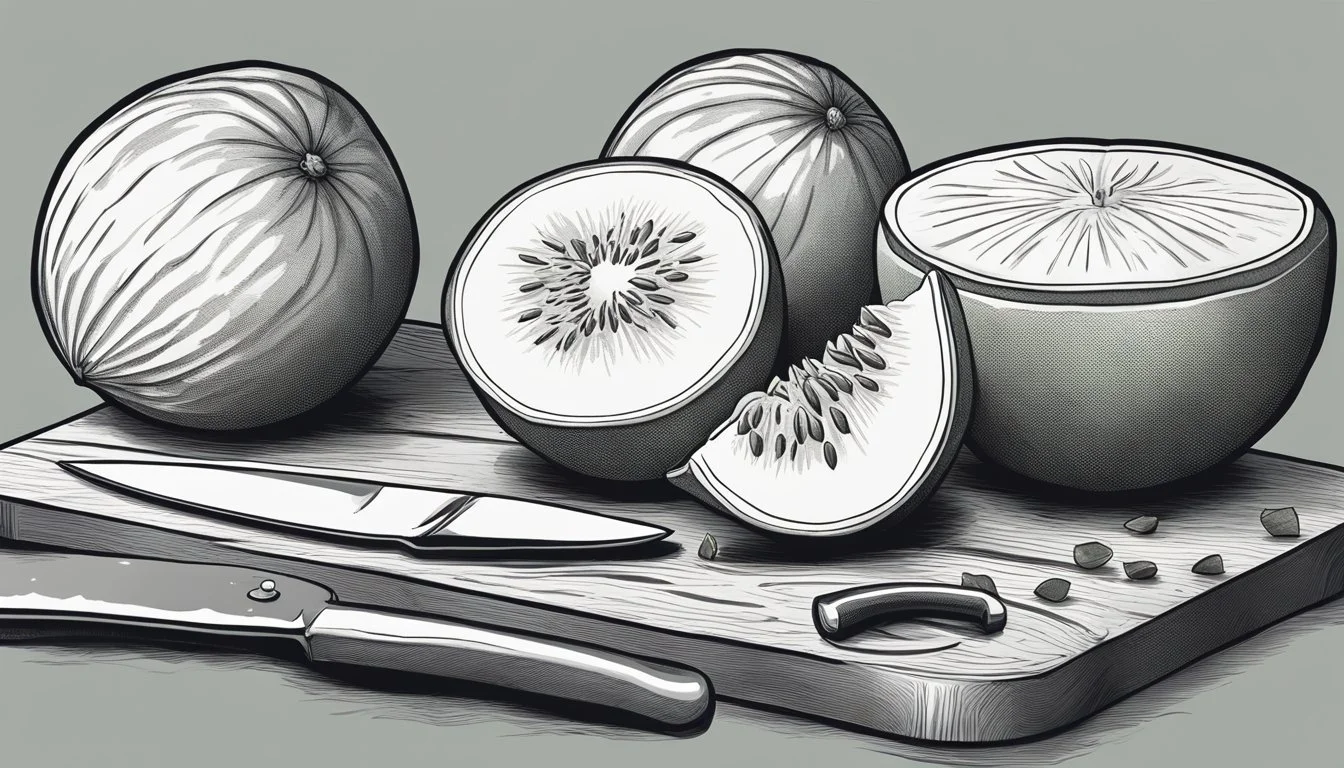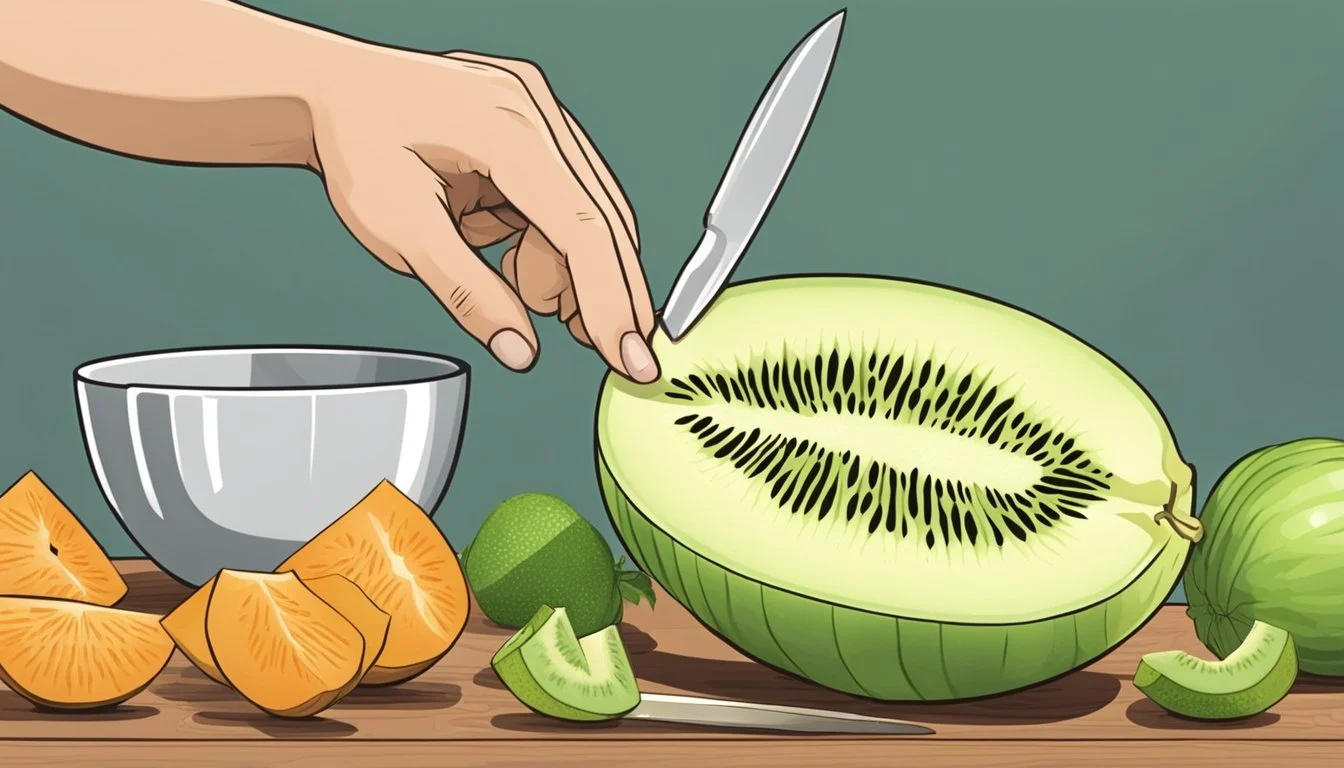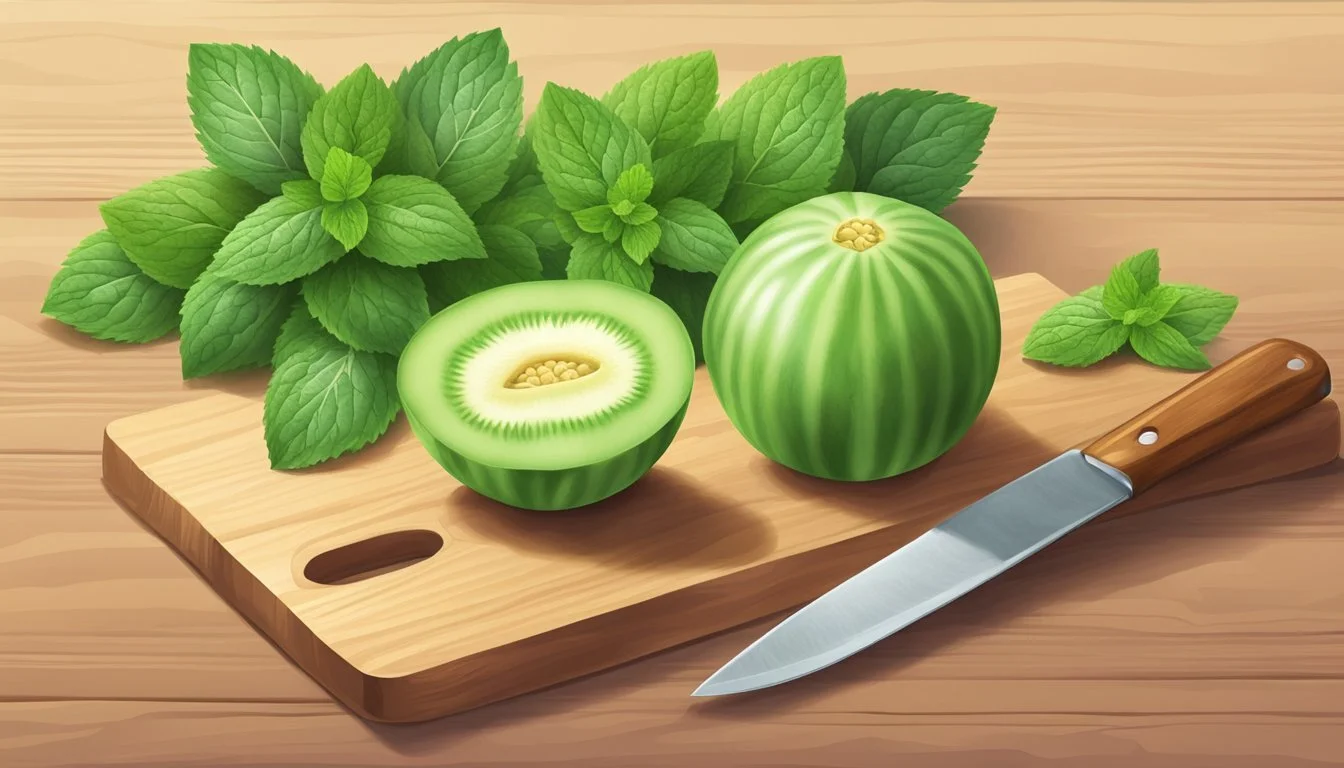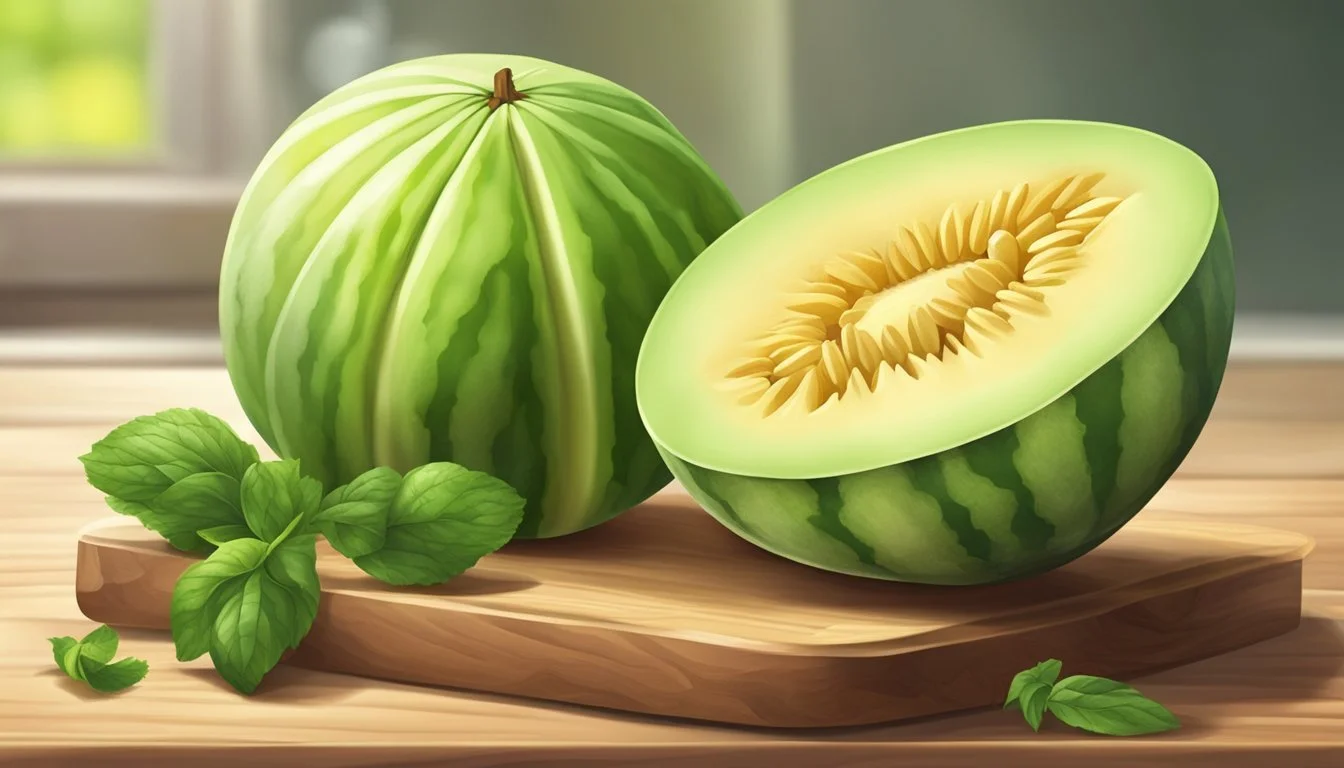How do you eat honeydew melon?
A Simple Guide to Enjoying This Sweet Fruit
Eating honeydew melon is a straightforward and enjoyable experience, best indulged when the fruit is ripe for its optimal sweet flavor. Honeydew melon, a pale green fruit, is recognized for its lush sweetness and juicy freshness which make it a favorite during warmer months. To consume this fruit, one should start by selecting a ripe honeydew with a subtly fragrant aroma and a rind that yields gently to pressure, ensuring the flesh inside is soft and sweet.
Preparing honeydew melon for consumption involves a few simple steps. The melon should be washed under cold water to remove any surface dirt or potential bacteria. With a sharp knife, the melon is cut in half lengthwise and the seeds are scooped out from the center. One can then place the flat side down on a cutting board to peel or slice the melon into the desired shapes and sizes. Whether served in wedges or cubes, the texture and sweetness of honeydew make it a versatile fruit that can be enjoyed on its own or paired with other foods.
The nutritional benefits of honeydew melon should not be overlooked. This fruit is a good source of essential vitamins and minerals, including vitamin C and potassium. Its high-water content contributes to hydration, which is especially beneficial in hot climates. By incorporating honeydew melon into one's diet, one can enjoy a nutritious snack that supports overall health while indulging in the fruit's natural sweetness.
Selecting the Perfect Honeydew Melon
Selecting the perfect honeydew melon involves assessing ripeness and examining the fruit's color and texture. The correct evaluation can lead to a sweet and enjoyable melon experience.
Identifying Ripeness
A ripe honeydew melon will emit a sweet, subtle fragrance. To test for ripeness, one should gently press the opposite end of the stem; a ripe melon will yield slightly under pressure. Another method is to tap the melon; a ripe one will produce a hollow sound, indicating the right level of firmness and internal development.
Understanding Color and Texture
Color: The skin of a perfectly ripe honeydew melon will be of a creamy yellow hue. An unripe melon's color may appear more greenish, while a melon with too much green or white patches can indicate it is not fully ripe.
Texture: The skin should feel smooth with a slightly waxy feel. Uneven texture or overly soft spots may be signs of over-ripeness or bruising. The uniformity of color combined with the ideal texture often signifies a honeydew melon ready to be enjoyed.
Nutritional Profile
Honeydew melon boasts a rich nutritional profile that caters to an array of dietary needs with its mix of vitamins, minerals, and macronutrients. This fruit is not only refreshing but also a beneficial addition to a balanced diet.
Vitamins and Minerals Content
Honeydew melon is an excellent source of vitamin C and potassium, with a significant contribution to the daily recommended intake of these essential nutrients. It also contains other vital vitamins and minerals, such as vitamin K, folate, magnesium, and B vitamins including vitamin B6. Here is a list of key vitamins and minerals found in honeydew melon:
Vitamin C
Potassium
Vitamin K
Folate (Vitamin B9)
Magnesium
Vitamin B6
Calcium
Iron
Phosphorus
Zinc
Calories and Macronutrients
In terms of macronutrients, a cup of balled honeydew melon, which weighs approximately 177 grams, is low in calories, with only about 64 calories. This makes it a desirable option for those monitoring their calorie intake. The same serving size contains roughly:
Protein: 1g
Carbohydrates: 16g
Sugar Content: Specific sugar content varies but is included within total carbohydrate count
Fiber: 1.4g
Fat: 0.3g
Its composition is predominantly water, which aids in hydration and provides a feeling of fullness with fewer calories. The carbohydrates in honeydew are mainly composed of natural sugars and fiber, which can promote digestive health.
Preparation Techniques
Proper preparation enhances the honeydew melon's sweet flavor and makes it easier to consume. Ensuring the fruit is ripe and handling it with care are fundamental steps for optimal taste and texture.
Proper Washing and Peeling
A honeydew melon must be washed to remove any external contaminants. Run it under cold water while gently scrubbing the surface. To peel, one should first cut off the ends of the melon to create a stable base. Peeling entails removing the rind with a knife or peeler, taking care not to remove an excessive amount of the sweet flesh.
Wash: Rinse under cold water.
Peel: Trim off ends, then slice away rind.
Cutting and Slicing
Once peeled, the honeydew can be cut in half lengthwise to access the seeds. They should be scooped out using a spoon. After deseeding, the honeydew melon can be further sliced according to preference, whether that be into wedges, cubes for fruit salads, or thinner slices for individual servings. If not consumed immediately, honeydew cubes or slices can be stored in the refrigerator or even frozen for later use.
Deseed: Halve the melon and scoop out seeds.
Slice: Cut into desired shapes.
Shape Method Wedges Cut from the center out to the edge. Cubes Further slice wedges into smaller squares. Slices Create thin pieces for immediate serving. Frozen Freeze cubes or slices for later consumption.
When a melon is ripe, it should emit a sweet fragrance and yield slightly under pressure. A ripe honeydew will offer the best flavor and texture whether served fresh or frozen.
Health Benefits
Honeydew melon offers a multitude of health benefits, primarily through its contributions to hydration and heart health. It is a fruit particularly rich in certain vitamins and minerals that play essential roles in maintaining bodily functions.
Hydration and Collagen Production
Honeydew melon is an excellent source of water, comprising a significant portion of its weight, which supports hydration. Adequate hydration is crucial for maintaining healthy bodily functions, including skin health. The fruit is also rich in vitamin C, an antioxidant that is imperative for collagen production. Collagen is a protein essential for the maintenance of healthy skin, and it also plays a part in preventing osteoporosis by supporting bone health.
Key Nutrients
Water content: High
Vitamin C: Approximately 34% of daily value per serving
Heart Health and Blood Pressure
Consuming honeydew melon may benefit heart health due to its content of potassium, which has been known to help manage blood pressure levels. Lower high blood pressure is associated with a reduced risk of heart disease. Honeydew melon also contains vitamin B6, which helps reduce levels of homocysteine in the blood, a marker linked to an increased risk of heart disease.
Key Nutrients
Potassium: Approximately 8% of daily value per serving
Vitamin B6: Supports regulation of homocysteine levels
Incorporating Honeydew into Diet
Honeydew melon, with its high vitamin content and versatility, can be easily integrated into one's diet through multiple culinary applications. It provides a refreshing flavor that can complement various kinds of dishes, from salads to snacks.
Creating Melon Salads
Fruit Salad: One can combine honeydew melon cubes or balls with an assortment of fresh fruits (What wine goes well with fruits?) to create a vibrant fruit salad. The juicy sweetness of the honeydew contrasts nicely with the tartness of berries or the citrusy notes of oranges. For a touch of sophistication, add a light drizzle of honey (What wine goes well with honey?) or a sprinkle of fresh mint.
Table: Suggested Fruit Salad Combos Featuring Honeydew
Combo Name Fruits Included Special Additions Tropical Delight Honeydew, pineapple, mango, kiwi Sprinkle of coconut Berry Melon Fusion Honeydew, strawberries, blueberries, raspberries Dash of lemon zest Citrus Burst Honeydew, orange segments, grapefruit, tangerine Drizzle of agave nectar
Salad Accompaniment: Honeydew melon can also be added to green salads. Pair it with mixed greens, cucumber, and a light vinaigrette for a fresh side dish. The natural sweetness of honeydew balances well with the savory flavors of salads.
Adding to Breakfast or Snacks
Breakfast Options: Honeydew can be a refreshing start to the day when added to breakfast bowls, such as yogurt or cottage cheese (how long does cottage cheese last?). Layer pieces of honeydew with creamy cottage cheese and granola for a balanced breakfast parfait.
Snack Pairings: For snacks, consider wrapping thin slices of honeydew with prosciutto for a classic Italian antipasto that offers both sweet and salty flavors. Alternatively, honeydew can be a star in a nutritious smoothie, blended with other fruits, spinach, or yogurt for an energizing snack.
Storage and Preservation
Proper storage is essential for maintaining the quality and extending the shelf life of honeydew melon. Whether one opts for countertop storage or refrigeration largely depends on the fruit's ripeness and how soon it will be consumed.
Countertop vs Refrigeration
Countertop:
Unripe: Honeydew melons that are not yet ripe can be stored at room temperature until they reach peak ripeness.
Duration: They typically last 3 to 5 days on the countertop.
Refrigeration:
Ripe: Once ripe or if purchased ripe and in-season, honeydews should be moved to the refrigerator.
Duration: In the fridge, a whole honeydew can stay fresh for 1 to 2 weeks.
Extending Shelf Life
Whole Melons:
To maximize longevity, keep the melon intact because cut surfaces accelerate spoilage.
Wrapping in plastic can help retain moisture and keep the fruit fresh.
Cut Melons:
Store in an airtight container or wrapped tightly in plastic to prevent drying out and absorbing odors.
They last approximately 3 to 4 days in the refrigerator.
By following these storage guidelines, one ensures their honeydew melon remains juicy and flavorful for as long as possible.
Recipe Ideas
Honeydew melon's sweet and refreshing taste makes it a versatile fruit in the kitchen. Creatively incorporated into various dishes, it can enhance both sweet and savory recipes.
Desserts and Sweet Treats
One can turn honeydew melon into frozen treats like popsicles. Simply puree the melon, mix with a hint of lime juice and honey, then freeze in popsicle molds. Additionally, honeydew sorbet is another delightful dessert, requiring only pureed melon, sugar syrup, and a touch of lemon, churned in an ice cream maker.
For a simple yet elegant option, use melon balls tossed in fresh mint for a melon salad that's perfect for ending a meal on a light, fruity note.
Savory Dishes and Pairings
Honeydew melon pairs exceptionally well with savory ingredients, making it a surprising component in soups. A chilled honeydew soup combines pureed melon with sautéed jalapenos, honey, and a pinch of white pepper for a refreshing summer dish.
Including honeydew in a platter with prosciutto creates a classic flavor combination— melon wrapped in cured ham. The melon's sweetness complements the salty ham, offering a sophisticated appetizer or snack.
Safety and Dietary Considerations
When consuming honeydew melon, one should consider potential allergies and the fruit's impact on blood sugar management. Awareness ensures individuals with specific dietary needs can enjoy honeydew melon safely.
Allergies and Food Sensitivities
Some individuals may experience allergic reactions to honeydew melon. Symptoms can range from mild to severe and can include itching, hives, or even anaphylaxis. It is important for those with known sensitivities to consult with an allergist. Honeydew is also low in sodium, making it a good option for those monitoring their sodium intake.
Diabetes and Blood Sugar Management
Honeydew melon, while nutritious, contains natural sugars that can affect blood sugar levels. For those managing diabetes, monitoring portion sizes is crucial. Below is a breakdown of honeydew's potential impact on blood sugar:
Glycemic Index: Medium (65±7, where 55 or less is considered low)
Carbohydrates: Approximately 16g per 1 cup serving, which can influence blood sugar levels
Those with diabetes should incorporate honeydew melon into their diet with consideration of their overall carbohydrate consumption and monitor their blood sugar level response post-consumption.
Culinary Variations and Related Fruits
Exploring the diverse world of melons enriches one's palate and provides insight into the variety and versatility of these fruits within the culinary spectrum.
Exploring Different Melon Types
Honeydew melons are known for their smooth, pale green rind and sweet, juicy flesh. They are part of the Cucurbitaceae family which hosts a variety of melons with unique flavors and textures. Cantaloupe (how long does cantaloupe last?), or rockmelon, often has a rough, netted rind and a more musky fragrance with a sweet taste that complements the light, mildly sweet flavor of honeydew melon.
Watermelon: Distinguished by its dense green rind and red, sweet flesh, often enjoyed in the summertime for its hydrating properties.
Varieties: Includes smaller specialty melons like Galia or the orange-fleshed Persian melon, expanding options for melon enthusiasts.
Substitutes and Complementary Flavors
When honeydew is unavailable or desired in combination with other flavors, various substitutes and complementary tastes can be embraced to achieve a similar or harmonious flavor profile.
Substitutes:
Cucumber: Though less sweet, provides a similar crisp texture
Pear or Peach: Fruits that can mimic honeydew’s sweetness
Complementary Flavors:
Pepper: A pinch can enhance the melon’s sweetness
Squash/Cucumbers: (how long do cucumbers last?) Vegetables from the same family that pair well in salads
Bold textures and contrasting tastes create culinary delights that can transform a simple honeydew melon into a diverse ingredient for a variety of dishes.






